75 Mighty Marvel Moments
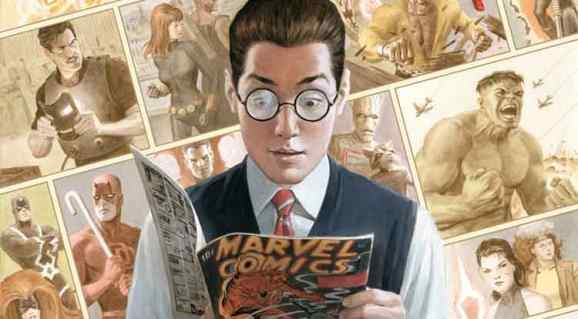
2014 has been a year to marvel. Marvel Comics has celebrated its 75th anniversary with regular posts on their website highlighting special moments in their history. Beginning to compile a list of the top 75 greatest Marvel accomplishments is an overwhelming task. Should this list be driven by sales, cultural impact, popularity or ingenuity? Who is to decide; the publishers and editors, Diamond Comic Distributors, creators, fans or a random anonymous survey group? What should this list include? Should it be the greatest single issues, characters, creators, marketing moves, toys, movies, games or cartoons? The list compiled here has taken months of research and countless rewrites. In no particular order, the list has three sections, creators, characters and storylines. From a lifelong comic fans perspective, the following list collects significant creators, characters and storylines that helped make Marvel Comics what it is today.
The Origin of Marvel Comics
In 1939, publisher Martin Goodman created Timely Publications which later became Timely Comics. Under the Timely banner, Goodman hired seasoned pulp magazine writers and artists such as Ben Thompson, Paul Gustavson, Bill Everett and Carl Burgos. These creators gave us some of the first comic book superheroes. During this Golden Age of comics, the foundation for modern-day comics was poured. Martin Goodman hired Joe Simon to serve as editor who in turn brought his artist friend Jack Kirby to Timely. Along with the hiring of his wife’s cousin, a 17-year-old named Stan Lee, these three creators would champion the future of superhero comics. In 1941 Joe Simon and Jack Kirby left Timely, leaving the job of editor to 19-year-old Stan Lee, who worked his way up from assistant/intern to lead the Timely Comics division. In 1951 Martin Goodman decided to publish his comic books under his umbrella publishing company Atlas. Atlas Comics analyzed popular trends in movies and television to distribute less superhero comics and more western, horror, war, crime and romance books.
It wasn’t until the late 1950’s, early 1960’s that DC Comics began to overtake the comic market with new superhero books like Flash and Green Lantern, joining DC mainstays Wonder Woman, Superman, Batman, Aquaman and Martian Manhunter to form The Justice League. Atlas Comics re-branded again as Marvel Comics and dedicated themselves to the superhero genre. Under the guidance of Stan Lee and Jack Kirby, Marvel introduced the world to the superheroes we know today.
75-51: The 25 Creators That Define Marvel Comics
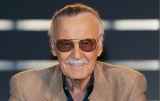
75: Stan Lee
Suggested Work: The Amazing Spider-Man #1-100 and Avengers #1-35
’nuff said. Every list that has to do with Marvel Comics should begin and end with Stan “The Man” Lee. He is the father of the superhero genre of comic books. Lee gave us flawed heroes with everyday problems we could believe in. Lee promoted the artists and writers of Marvel as much as their creations. He created a brand and a marketing strategy still used today.
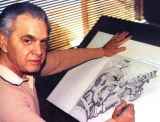
74: Jack Kirby
Suggested Work: X-Men #1-11, Fantastic Four # 1-102 and Avengers #1-8
He’s the “King”. If Stan Lee brought all the early superheroes to life, Jack Kirby gave them a soul. Kirby’s use of scale lent itself to characters like Hulk, Thing, Beast, Giant Man and Wasp. His pencils defined superhero illustration and became a template for aspiring artists.
73: Joe Simon
Suggested Work: Captain America Comics #1-10
He helped form Timely comics and bring it to the forefront of pulp publishing with romance and horror comics. With Captain America, he gave the U.S. a real hero to believe in. Creative differences and personality conflicts forced Simon to leave Timely and he unfortunately missed the formative years of Marvel Comics. During this time Simon had a lucrative career in advertising.
72: Steve Ditko
Suggested Work: The Amazing Spider-Man #1-38 and Strange Tales #67-146
In Marvel’s formative years, if Kirby didn’t do it, Ditko did. Often overlooked but not overshadowed. Defined Spider-Man and his amazing rogues. Ditko’s fluid pencils gave shape to the mystical realm of Marvel Comics. He created Dr. Strange and fan favorite Squirrel Girl.
71: John Romita Sr. & Jr.
Suggested Work: John Romita Sr. – The Amazing Spider-Man #39-58 and Captain America #138-145
John Romita Jr. – Daredevil: Man Without Fear #1-5 and Avengers vol. 4 #1-12
Father and son duo that dominated the art duties at Marvel for 2 generations. Stan Lee poached John Sr. from DC Comics and his depiction of Spider-Man became the signature look for generations. John Jr. has kept to his classic superhero style through the years. As illustration trends evolved, his work has gotten stronger and become nostalgic as an homage to the early days of Marvel and Jack Kirby.
70: John and Sal Buscema
Suggested Work: John Buscema – Avengers #49-62, 255-279, 281-300 and Savage Sword of Conan #1-5
Sal Buscema – Incredible Hulk #280-309, Captain America #146-163, 165-181 & Spectacular Spider-Man #134-213
There is no greater tandem of Avenger artists than brothers, John and Sal. The iconic images of Hulk, Silver Surfer and Captain America belong to them. John defined Silver Surfer and the transitional period of the Avengers from the core team to new members. He also helped bring Conan to the forefront of popular culture by illustrating over 200 of his stories. Sal had lengthy runs on Captain America, Hulk and Spectacular Spider-Man carrying these characters into the 1980’s and evolving their designs slightly to a more contemporary style.
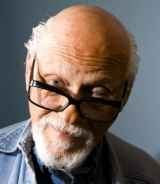
69: Gene Colan
Suggested Work: Daredevil #20–49, 53–82, 84–100 and The Tomb of Dracula #1-70
Kept the horror genre alive and biting for decades while transitioning to superhero comics. A true master of line work. Gene Colan was one of a very few artists that was able to tell Stan Lee “no”. Colan’s style was very different from Kirby and Ditko and he stood by his art and would not compromise to fit into Stan Lee’s mold. Colan created the characters Falcon and Blade.
68: John Byrne
Suggested Work: Fantastic Four #232-293 and X-Men #129-138
John Byrne’s vision of the X-Men and Fantastic Four is iconic. He illustrated The Dark Phoenix Saga and Days of Future Past, arguably the greatest X-Men stories ever told. He brought the Fantastic Four back to their roots as a hybrid superhero/sci-fi title. If he didn’t leave for DC Comics he could have solidified his reputation as the second coming of Kirby for Marvel Comics.
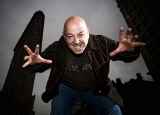
67: Brian Michael Bendis
Suggested Work: Ultimate Spider-Man #1-133, Ultimate Comics Spider-Man #1-28, crossover events: Secret War, House of M, Secret Invasion, Siege and Age of Ultron
If Stan Lee is the father of superhero comics, Bendis is his heir. He helped shape the Ultimate Universe then blew up the Marvel Universe and rebuilt it. Bendis can seemingly write anyone and anything. He has re-designed the blueprint of the Marvel Universe with crossover events that have depth, intrigue and repercussions that last beyond their published run. A once in a generation creator that seems to gain momentum and insight every Wednesday.
66: Chris Claremont
Suggested Work: Uncanny X-Men #94-279 and Excalibur #1-19
Claremont has an uncanny ability to captivate readers with not only hard-hitting action but the mundane inaction of a superheroes life. He was the first to show us what happens at Xavier’s School when there isn’t an emergency. Claremont wrote nearly every major X-Men story for 16 years creating characters such as Emma Frost, Psylocke, Gambit, Shadowcat, Mystique, Captain Britain, Phoenix and others. He had a knack for writing strong female characters as equals and not submissive sidekicks.
65: Jim Lee, Todd McFarlane, Rob Liefield & Marc Silvestri
Suggested Work: Jim Lee – Uncanny X-Men #267-277, X-Men vol. 2 #1-11 and Punisher War Journal #1-12 – Todd McFarlane – Amazing Spider-Man #298-323, Spider-Man #1-14 and Incredible Hulk #330-334, 336-345 – Rob Liefield – New Mutants #85-100 and X-Force #1-13 – Marc Silvestri – Wolverine #31-43 and Uncanny X-Men #238-244
The late 80’s and early 90’s in Marvel brought about an extreme high with these 4 guys leading the charge. They were amazing artists that were given the reigns of some of Marvel’s prized commodities. This group gave us memorable covers and interiors to X-Men, Spider-Man, Hulk, Wolverine, X-Force and New Mutants. When they quit to form Image Comics they took the brunt of the blame for bottoming out the comic market which led to Marvel filing for bankruptcy.
64: Mark Millar and Bryan Hitch
Suggested Work: Ultimates #1-13, Ultimates vol. 2 #1-13 and Fantastic Four #554-569
The dream team. Millar and Hitch (along with Bendis and Bagley) mapped out Marvel’s Ultimate Universe. They created The Ultimates and in turn the creative pool for Marvel Studios. Their run on Fantastic Four brought Dr. Doom back into the light as Marvel’s First Family’s greatest villain. Hitch’s aggressive line work works well with Millar’s gritty writing.
63: Mark Bagley
Suggested Work: Ultimate Spider-Man #1-111 and New Warriors #1-25
111 straight issues of Ultimate Spider-Man. Runs on Thunderbolts, Captain America and Fantastic Four solidify him as a powerhouse workhorse in Marvel’s stable. Bagley has a classic, youthful style that worked perfectly for Ultimate Spider-Man and New Warriors. His facial expressions are able to capture emotions without the need of words.
62: Arthur Adams
Suggested Work: Fantastic Four #347-349, Longshot #1-6 and Ultimate Comics: X #1-6
A style like no others. Arthur Adams sticks with his style for every character. His playfully detailed but dynamic style is timeless and inspiring. Adams is an artist that took time to develop a complete style. He had to work hard to interpret scripts and to understand perspective. Marvel invested the time into training him and it paid off in classic images of Wolverine, the new Fantastic Four (Hulk, Spider-Man, Ghost Rider and Wolverine) and the X-Babies.
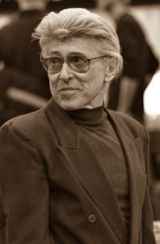
61: Jim Steranko
Suggested Work: Nick Fury: Agent of S.H.I.E.L.D. #1-7 and Strange Tales #151-167
Steranko is a master of design. His page layouts should be studied each day by aspiring comic artists. He began his career as an illusionist and magician. It is not surprising that his art has such dynamic design. He gave Nick Fury the super spy treatment and iconic covers that were a blend of surrealism, James Bond and optical illusions.
60: Bill Sienkiewicz
Suggested Work: Elektra: Assasin #1-8, Moon Knight #1-15 and New Mutants #18-31
Sienkiewicz, like wine, gets finer with age. He has ramped up productivity over the past few years and his style has evolved into the perfect blend of fine art and illustration. His style is immediately recognizable and provided the gritty backdrop to Moon Knight and the violence and chaos that surrounds Elektra.
59: J. Michael Straczynski
Suggested Work: Amazing Spider-Man vol.2 #30-58, Amazing Spider-Man #500-524, Thor #1-12 and Strange #1-6
JMS has a foothold in television and film. We are lucky enough to have him write comics as well. He wrote seminal volumes of Amazing Spider-Man, Fantastic Four, Dr. Strange and Thor. His first 12 issues of Thor are a beautifully crafted epoch for the greatness the Thunder God deserves. JMS is one of the writers (like Bendis) that helped bring Marvel up to the level it has reached today.
58: Peter David
Suggested Work: The Incredible Hulk #331-359, 361-467 and X-Factor #1-50
“Writer of Stuff” is Peter David’s self-imposed title. David took X-Factor out of the 90’s and relaunched it as an alternative to Xavier’s School as a detective agency with more adult themes. He wrote The Incredible Hulk for 12 years. Under David’s pen, he explored Bruce Banner as a sufferer of multiple personality disorder and his struggle to keep his 3 personalities together was the theme of his run. The Hulk went from a floundering monster to a tragic hero with depth under Peter David’s guidance.
57: Walt Simonson
Suggested Work: X-Factor #10-15, 17-39 and Thor #260–271, 337–355, 357–382
Artist/writer extraordinaire, Simonson, matured Marvel’s original X-Men and helped transition Thor through the 1980’s. Simonson took over writing duties to go along with his art on Thor and has gained notoriety for creating Throg, Frog of Thunder and Beta Ray Bill. During his run on X-Factor he helped shape the villain Apocalypse and his Horsemen including Archangel. Walt Simonson’s main collaborator throughout his career is his wife Louise, an accomplished comic writer with an extensive bibliography.
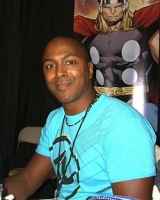
56: Olivier Coipel
Suggested Work: House of M #1-8, Thor #1-6, 9-12 and The Mighty Thor #1-6
Coipel breathed life into the darkest times of the X-Men by illustrating House of M. He also gave Thor a re-design that is now his signature style. Coipel has a style with exquisite detail that is consistent and clean. Coipel utilizes negative space well and his line work id influenced by Gene Colan. The youngest creator on the list has already affected Marvel and looks to keep his momentum going.
55: Jim Starlin
Suggested Work: Infinity Gauntlet #1-6 and Silver Surfer #34-48, 50
Mr. Cosmic, Jim Starlin took Silver Surfer from Marvel Comics and expanded his universe infinitely. He is the brains behind Thanos and helped re-brand many of the cosmic heroes in the Marvel Universe. He wrote the classic Infinity Gauntlet and the 3 follow-up mini series. Starlin wrote and illustrated many of his titles and was the creator of Thanos, Gamora, Drax The Destroyer and Shang Chi, Master of Kung-Fu.
54: George Pérez
Suggested Work: Infinity Gauntlet #1-3, Avengers vol.3 #1–15, 18–25, 27–34 and Hulk: Future Imperfect #1-2
Artist for Incredible Hulk, FF, Avengers and Infinity Gauntlet. Pérez is famous for his classic superhero style of drawing and his ability to fill a page/cover better than anyone else in the industry. Pérez is such an asset to comics that his style has pulled him between Marvel and DC for his entire career. He would make this same list for DC Comics.
53: Ed Brubaker
Suggested Work: Captain America vol.5 #1-50, 600-619, vol.6 #1-19 and The Immortal Iron Fist #1-14
Joe Simon should feel honored that Ed Brubaker took an interest in Captain America. Brubaker is responsible for updating Captain America and forcing him to the forefront of the Marvel Universe back where he belongs. He created the Winter Soldier and a variety of new villains for Captain America. He broke out of the Hydra/Nazi template and diversified his rogues gallery. Brubaker also wrote a great run on The Immortal Iron Fist where he dug into the origins of Danny Rand and the mystical city of K’un-Lun.
52: Frank Miller
Suggested Work: Daredevil: Man Without Fear #1-5, Daredevil # 158-191, 227-233 and Elektra: Assassin #1-8
Frank Miller is a writer and artist that has given the comics industry some of the best stories ever told, Sin City, The Dark Knight Returns and Daredevil: Born Again. Miller brought Daredevil from relative obscurity to the height of popularity with his writing and drawing. He gave life to Daredevil’s greatest enemy and foil in Bullseye and Elektra. Under Miller’s guidance Matt Murdock lost everything; his job, money apartment, love, friends and purpose. Thankfully Daredevil was Born Again and became a fixture in New York City similar to Spider-Man.
51: Len Wein
Suggested Work: Giant-Size X-Men #1, Incredible Hulk #180-182 and Amazing Spider-Man #176-180
Len Wein resurrected the X-Men with Giant-Size X-Men #1 and is responsible for creating Wolverine, Colossus, Nightcrawler and Storm. He plotted the “new X-Men’s initial storyline that Chris Claremont wrote. He had long runs writing, The Amazing Spider-Man, The Incredible Hulk, Fantastic Four and Thor. Wein is often overlooked for his contributions to Marvel Comics but his impact and influences are still effecting Marvel Comics today such as the X-Men. Like George Pérez Wein would make this list for DC Comics as well.
50-26: The Superhero Hall of Fame
50: Spider-Man
1st Appearance: Amazing Fantasy #15, 1962
Created by: Stan Lee & Steve Ditko
Marvel Comics mascot and mainstay. Spider-Man has a clever rogues gallery that continues to harass him hundreds of issues later in print, movies, toys, video games and cartoons.He is the most branded superhero in Marvel Comics and is an icon of pop culture. He has suffered more than any other hero and has become a model of perseverance and determination, much like his home, New York City.
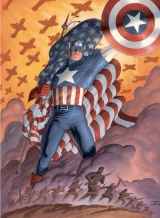
49: Captain America
1st Appearance: Captain America Comics #1, 1941
Created by: Joe Simon & Jack Kirby
Fighting injustice since 1941. Simon and Kirby gave the U.S. a hero that was relevant and logical to support. While war comics were gaining popularity, they created a figure-head to the genre that evolved into Marvel Comic’s greatest superhero.
48: Iron Man
1st Appearance: Tales of Suspense #39, 1963
Created by: Stan Lee, Larry Lieber, Don Heck & Jack Kirby
A hero born of the cold war and capitalism. Often compared to DC Comic’s Batman, Tony Stark decided to embrace the fame of being Iron Man. The eternal narcissist, Tony Stark has become the perfect foil to Captain America. They are friends that often disagree but unify for the greater good.
47: Thor
1st Appearance: Journey Into Mystery #83, 1962
Created by: Stan Lee, Larry Lieber & Jack Kirby
Marvel does not invest as much into mythology as DC Comics does. Thor is their shining example and has finally been raised to the Prime Hero status he deserves, much like Superman. Thor’s storylines in Asgard are a welcome change of pace to the real cities Marvel Comics inhabit.
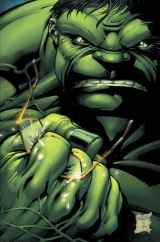
46: Hulk
1st Appearance: Incredible Hulk #1, 1962
Created by: Stan Lee & Jack Kirby
Hulk SMASH! the Jade Giant is Stan Lee and Jack Kirby’s greatest creation. He is everything they set out to create. Hulk is a flawed superhero with extraordinary powers. Bruce Banner is a genius who has trouble interacting with the real world. He has anger issues. He is eternally in love with Betty Ross the daughter of his greatest adversary. The Incredible Hulk has always been a story of emotions; rage, anger, love and remorse.
45: Fantastic Four
1st Appearance: Fantastic Four #1, 1961
Created by: Stan Lee & Jack Kirby
The first super team and family in Marvel Comics. In the Baxter Building lives the Fantastic Four. Reed Richards and his friend Ben Grimm joined with Reed’s eventual wife Sue Storm and her hot-headed brother Johnny. The dynamics within this group continues to work 53 years later. They have welcomed 2 children into their family, Franklin and Valeria. The FF are the Earth’s first line of defense for any alien invasions and Reed Richards is the mind behind Marvel’s greatest prisons and other inventions like The Ultimate Nullifier.
44: X-Men (original) & Magneto
1st Appearance: X-Men #1, 1963
Created by: Stan Lee & Jack Kirby
When racial injustice was at a high in this country Stan “The Man” and “King” Kirby gave us Marvel’s minority group, mutants. The face of comics would be forever influenced by the relationships of these mutants to each other and the rest of the Marvel Universe. It is hard to imagine the Marvel Universe without mutants.
43: Wolverine
1st Appearance: Incredible Hulk #181,1974
Created by: Roy Thomas, Len Wein & John Romita Sr.
He’s the best there is at what he does. Wolverine was an instant hit when he debuted. His background is mysterious and complicated to this day. He has been a member of every major super team in Marvel, X-Men, X-Force, Alpha Flight, Avengers, S.H.I.E.L.D., Weapon X and Fantastic Four. Wolverine still struggles with the balance between hero and animal. Often times he goes berserk and he gives in to the animal instincts that haunt him.
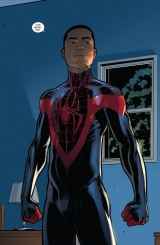
42: Miles Morales
1st Appearance: Ultimate Fallout #4, 2011
Created by: Brian Michael Bendis & Sara Pichelli
When Bendis and Bagley introduced Ultimate Spider-Man they gave us a re-telling of Peter Parker’s history from his perspective. It was genius. Bendis amazed us again with Miles Morales. A young hero, Miles has no idea what he is doing. He just knows he wants to honor Peter Parker and carry the mantle of Spider-Man with pride. Miles is America today. He is bi-racial, excited, distracted, adventurous and scared. He is the future of contemporary superheroes.
41: Dr. Doom
1st Appearance: Fantastic Four #5, 1962
Created by: Stan Lee & Jack Kirby
Doom is an Empirical ruler of his own nation whose only goal in life is to ruin the lives of superheroes so he can rule in their absence He is unique in that he wields the power of magic and technology. Dr. Doom is the most dangerous villain in Marvel Comics. If he dedicated himself to taking over the world, he could do it. His problem is he gets bored. He searches for challenges to overcome, however, these challenges tend to lean toward evil intentions.
40: Red Skull
1st Appearance: Captain America Comics #7, 1941
Created by: Joe Simon, Jack Kirby & France Herron
Is there anything more villainous than a power-hungry Nazi? Classic villain meets real world crazy. Red Skull is a hateful villain. He has recently turned his hate toward mutants and the Uncanny Avengers, a hybrid X-Men/Avengers team.
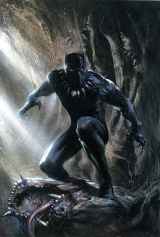
39: Black Panther
1st Appearance: Fantastic Four # 52, 1966
Created by: Stan Lee and Jack Kirby
King of Wakanda. Avenger. Genius. Superhero. The only real presence outside of the United States in Marvel Comcis. T’Challa rules over Wakanda and manages the world’s supply of vibranium. He is a member of The Illuminati, the governing body that oversees the greatest threats to Earth.
38: Punisher
1st Appearance: Amazing Spider-Man #129, 1974
Created by: Gerry Conway, Ross Andru & John Romita Sr.
Marvel Comics greatest anti-hero. Marvel Knights was a line designed for Punisher. He brought the MA rating to Marvel Comics. He is a necessary evil that S.H.I.E.L.D. and the Avengers allow to operate. He deals with street level threats like gangs, drug dealers and the mafia. Frank Castle was the first mainstream Italian-American superhero.
37: Daredevil
1st Appearance: Daredevil #1, 1964
Created by: Stan Lee & Bill Everett
Matt Murdock has overcome his disability with grace and power. He grew from a scared little boy to The Man Without Fear. Daredevil lives and works in Hell’s Kitchen, New York and rarely ventures out of his region. He has a core group of loyal friends including Spider-Man, Luke Cage, Iron Fist, Elektra, Echo and his law partner Foggy Nelson.
36: Storm
1st Appearance: Giant-Size X-Men #1, 1975
Created by: Len Wein & Dave Cockrum
Storm has been a great role model for female readers. She is a strong, dynamic and respected leader in the Marvel Universe. She is now the rightful Queen of Wakanda after marrying Black Panther. Storm has been an Avenger and has led the Morlocks and the X-Men.
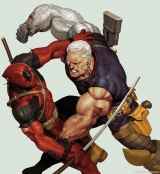
35: Cable & Deadpool
1st Appearance: New Mutants #98, 1991
Created by: Fabian Niciezia & Rob Liefield
The best thing to come out of Marvel Comics in the early 90’s is this on again, off again duo. They have had their own series’ and a joint series. Cable now leads his own team of X-Force and Deadpool marches to the beat of his own drum. Cable has carved out a sci-fi style time traveling niche in his end of the universe and Deadpool has evolved into the 4th wall breaking over the top “Merc With a Mouth”.
34: Green Goblin
1st Appearance: Amazing Spider-Man #14, 1964
Created by: Stan Lee & Steve Ditko
Overbearing father meets wealthy egomaniac. Spider-Man’s signature villain and Peter Parker’s greatest emotional challenge. Norman Osborn is the father of Peter’s good friend Harry and it hurts Peter to see his friend be abused and ignored by his father. The emotional torment mixed with physical attacks is what keeps Green Goblin as the most draining of Spider-Man’s villains.
33: She-Hulk
1st Appearance: Savage She-Hulk #1, 1970
Created by: Stan Lee and John Buscema
Shulkie has had many ups and downs in popularity through the years. A strong successful woman as either a lawyer or a brute keeps a lighthearted attitude that makes her a great foil to her cousin. She-Hulk is more than she appears. The mix of brains, brawn and charisma keep her as a valuable superhero in Marvel as she can fit seamlessly into any storyline.
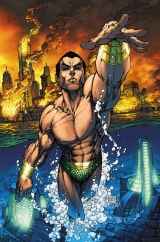
32: Namor, The Sub-Mariner
1st Appearance: Marvel Comics #1, 1939
Created by: Bill Everett
Not only the first mutant, but the first Marvel superhero. He is equal parts, Dr. Doom, Thor, Wolverine, Captain America and Hulk. Namor is everything DC Comics Aquaman wants to be. He is arrogant, powerful, commanding and respected. Namor does what he wants, when he wants to do it. He rules over Atlantis and rises to defend his friends when he is needed.
31: Dr. Strange
1st Appearance: Strange Tales #110, 1963
Created by: Stan Lee & Steve Ditko
Dr. Strange is a character that has been forgotten at times but when the Marvel Universe is in peril he is normally the last resort. The Sorcerer Supreme has his niche within the magic realm and is respected by all hero factions. Dr. Strange is a former surgeon turned superhero who is Marvel’s mystical problem solver. He is the one who brought Scarlet Witch back from House of M and has also been one of the few people to bring Hulk down from his rampage.
30: Galactus
1st Appearance: Fantastic Four #48, 1966
Created by: Stan Lee & Jack Kirby
Epic level villain that played off of the original readers xenophobia. The World Eater was the first to unify Marvel heroes to fight against a common enemy. Galactus has become more than a villain. He has evolved into force of nature. He summons Heralds to find planets for him to devour. Typically when a Herald arrives, it is already to late for your planet. Galactus is coming.
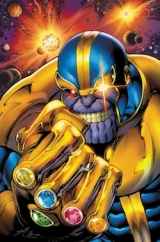
29: Thanos
1st Appearance: Iron Man #55, 1973
Created by: Jim Starlin
Thanos is the villain that chooses when he wants to torment the Marvel Universe. He does this at his own whim and the entirety of the Marvel Universe must stop him. Thanos is in love with Death herself. The character Death is the physical manifestation of death. She is a shrouded skeletal figure that cursed Thanos to exist eternally between the realms of life and death. His curse was invoked after he destroyed the entire universe to be with her.
28: Falcon
1st Appearance: Captain America Comics #117, 1969
Created by: Stan Lee & Gene Colan
The Falcon is Marvel Comics first black superhero. He has been a confidant and partner to Captain America for 45 years and is slated to take up the mantle of Captain America this year. Sam Wilson is a reformed criminal that has treated his second chance as a new life. His rise in popularity is long overdue and Marvel Comics is grooming him to take on a larger role.
27: Nick Fury
1st Appearance: Sgt. Fury and His Howling Commandos #1, 1963
Created by: Stan Lee & Jack Kirby
Nick Fury is the character that bridged the gap between Atlas Comics war stories and Marvel Comics superhero comics. He is an everyday soldier who rose through the ranks to lead the major government agency in Marvel, S.H.I.E.L.D. With the creation of The Ultimates, Fury has become 2 very distinctly different characters. The mainstream Marvel Universe has the war hero of Earth 616 continuity and the Ultimates have the Samuel L. Jackson inspired super spy of the Ultimate Universe.
26: The Ultimates
1st Appearance: The Ultimates #1, 2002
Created by: Mark Millar & Bryan Hitch
When the Ultimate Universe launched, Marvel created another timeline for its characters. Bendis and Bagley made Spider-Man relevant again and Millar and Hitch created The Ultimates. The Ultimates are the response to; what if the Avengers existed today, in present day New York City? The result is a hard-hitting, accessible universe that has served as the basis for Marvel Studios and many of their successful films.
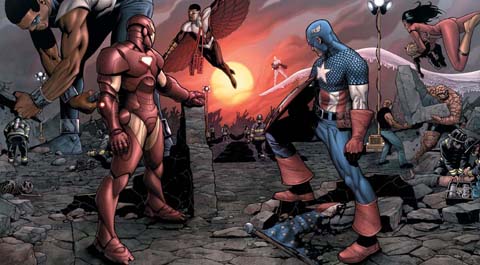
25-1: The 25 Stories/Moments That Shaped a Universe
25: Civil War
Civil War # 1-7, 2006, 2007 – crossover event
Mark Millar & Steve McNiven
“Whose Side Are You On?” Readers are forced to choose between supporting Iron Man and the Superhero Registration Act or Captain America and his resistance. The premise was simple, heroes are now required to register their secret identities with the government and work as sanctioned agents of S.H.I.E.L.D. or the Avengers Initiative. Failure to sign up results in imprisonment and being labeled a fugitive. Civil War ended with Captain America turning himself in and being assassinated(presumably). Civil War is a great story that feeds from many cultural fears including; WWII era Nazi tactics, post 9/11 terrorist threats, “big brother” and general government issued control.
24: Infinity Gauntlet
Infinity Gauntlet #1-6– 1991
Jim Starlin, George Perez & Ron Lim
One of the greatest love stories ever told in Marvel Comics. Thanos constructs the Infinity Gauntlet and kills half of the universe in a gesture to win the heart of Death. The Infinity Guantlet houses the Infinity Gems; time, space, soul, power, reality and mind. The wielder is omnipotent and virtually unstoppable. The remaining heroes band together with Marvel’s celestial entities including Galactus only to fall under his power as well. Thanos would eventually be defeated but this story is the beginning to a decades long battle between Thanos and the Marvel Universe.
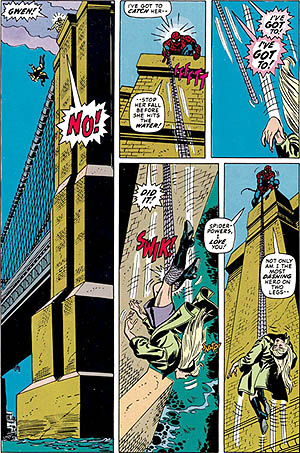
23: Gwen Stacy’s death
Amazing Spider-Man 121-122, 1973
Gerry Conway, Gil Kane & John Romita
Gwen Stacy and Peter Parker were the perfect couple headed down the road of marriage and a family. Marvel cited difficulties in aging Peter Parker and plotting for him as an adult as reasons on why Gwen was killed off. The result was a shock to readers and the public. The awe of a superhero failing and a non hero dying were equally terrifying. This moment was a turning point in Spider-Man’s life. The guilt of Gwen’s death is a driving force that defines his character as much so as losing his Uncle Ben.
22: Dark Phoenix Saga
The X-Men # 129-138, 1980
Chris Claremont, John Byrne & Terry Austin
The Phoenix force has developed into a cosmic power that can corrupt absolutely. The Dark Phoenix Saga takes the heart and soul of the X-Men, Jean Grey and offers her up as a sacrificial lamb. Guilt ridden from destroying a planet and its occupants, Jean takes her own life to save the rest of the universe. Uatu the Watcher sums up the life of Jean Grey perfectly at the end of the storyline; “Jean Grey could have lived to become a god. But it was more important to her that she die…a human.”
21: Secret Invasion
Secret Invasion 1-8, 2008-2009 – crossover event
Brian Michael Bendis & Leinil Francis Yu
Bendis crafted a story that redirected readers anger from other heroes back to a common villain, the Skrulls. Civil War left readers with unresolved feelings and as the master storyteller he is Bendis gave us a mystery, spy, suspense, action and thriller all in one. The Skrulls replaced many of Earth’s heroes with their own shape shifting counterparts and infiltrated every corner of the Marvel Universe. The resulting war reshaped the power dynamics in Marvel and eased readers back into supporting characters they may have grown angry with because of Civil War. Readers were no longer asked “Whose Side Are You On?”, but “Who Do You Trust?”
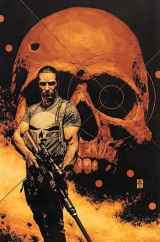
20: Welcome Back, Frank
The Punisher #1-12, 2000-2001
Garth Ennis, Steve Dillon & Timothy Bradstreet
Under Marvel’s new Marvel Knight imprint Frank Castle, The Punisher turns back to the streets of New York and re-focuses his energy to bringing down organized crime. This was the first of Marvel’s new line of comics that had more violence, harsher language and graphic content. Ennis redefined Frank Castle and gave him a platform to work independently from the rest of the Marvel Universe.
19: Green Goblin Reborn
The Amazing Spider-Man #96-98
Stan Lee, Gil Kane & John Romita
Possibly one of the more culturally significant stories Marvel published. Due to the rise of comic book popularity, Stan Lee was asked by President Nixon’s administration to write a story that condemned drug use. The story introduces readers to Harry Osbourne popping pills and eventually overdosing. Spider-Man forces Green Goblin to see Harry in the hospital and Norman Osborne loses the Goblin identity and becomes a father again, for a moment. The story led to the reform of The Comics Code Authority as they saw the positives of taking a stand against drug use outweighed the exposure of drug use to children. A chance encounter on a rooftop with a drug addict inspires Peter to state; “I would rather face a hundred super-villains than throw my life away on hard drugs, because it is a battle you cannot win!”
18: New X-Men introduced
Giant-Size X-Men #1, 1975
Len Wein & Dave Cockrum
Just as the X-Men were getting stale and possibly cancelled, Len Wein and Dave Cockrum introduced Wolverine, Colossus, Nightcrawler, Storm and Thunderbird as the “New X-men”. This issue was the first original X-Men story in 5 years. Marvel was reprinting older stories in lieu of new content. Not only did Marvel introduce new mutants but they provided a great deal of diversity to their relatively homogenous pool of heroes. Thuderbird is American Indian, Storm is an African woman, Nightcrawler is a devout catholic and Colossus is a Russian protagonist, not a villain.
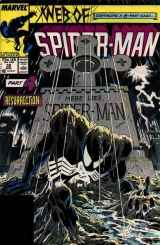
17: Kraven’s Last Hunt
Web of Spider-Man #31-32, The Amazing Spider-Man #293-294, and The Spectacular Spider-Man #131-132, 1987
J.M. DeMatteis & Mike Zeck
A story that had a great origin, DeMatteis had this plot rejected by Marvel and DC for characters like Wonder Man and Batman. The simple concept of what happens if a hero falls to his villain. In this case, Kraven seemingly kills Spider-Man and takes his place. As Spider-Man, Kraven captures Vermin, a villain Spider-Man could not defeat alone. Having completed his greatest hunt, Spider-Man, and accomplishing something the original could not, Kraven takes his life and leaves a note for police outlining his last hunt and his role as Spider-Man, along with photos. The repercussions stay with Spider-Man for years to come. He does not forget that he was defeated. He understands the decisions he makes resonate in his expansive world. Mike Zeck illustrated this journey with iconic images of Spider-Man struggling against his adversary.
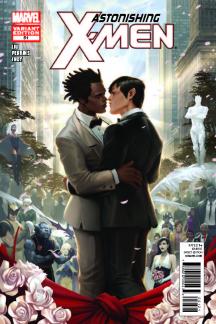
16: Northstar’s wedding
Astonishing X-Men # 50-51, 2012
Marjorie Liu & Mike Perkins
Jean-Paul Beaubier aka Northstar, founding member of Alpha Flight and current X-Man became the first openly gay superhero in comics history within the pages of Alpha Flight #106 in 1992. Twenty years later, Northstar proposes to and weds his partner Kyle Jinadu. Cultural milestone aside, the conversations between Northstar and Kyle are some of the most realistic, heartfelt dialogue written in comics. They both question the sanctity of marriage; are we moving to fast, the logistics of their relationship and two people with different backgrounds living together forever. They raise very real questions that every couple deals with in their own ways. Marvel does not shy away from some characters being uncomfortable and/or disagreeing with the union. They embrace the dialogue respectfully and without a definitive opinion. Liu allows readers to keep their own beliefs without an isolating right or wrong tone.
15: Ultimate Universe introduction
The Ultimates # 1-6, 2002
Mark Millar & Bryan Hitch
Ultimate Spider-Man # 1-7, 2000-2001
Brian Michael Bendis & Mark Bagley
Ultimate X-Men #1-6, 2001
Mark Millar, Adam Kubert(#1-4) & Andy Kubert(#5,6)
If it wasn’t for Millar and Bendis, superhero movies would not have had the styling and edge their films have needed. The Ultimate Universe was an immediate hit. The characters were re-imagined in contemporary times and were seemingly written with an adult audience in mind. The Ultimate Universe breathed life into Marvel Comics when they desperately needed it. In the formative years of The Ultimate Universe; Hulk goes berserk because Betty Ross is on a date with Freddie Prinze Jr. Peter Parker works for the online department of The Daily Bugle. The original Ultimate X-Men are Professor X, Cyclops, Jean Grey, Storm, Beast, Colossus and Iceman. Captain America kicks Hulk in the groin and beats Hank Pym for hitting a woman(Wasp).
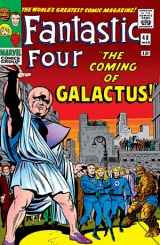
14: The Coming of Galactus
The Galactus Trilogy, Fantastic Four #48-50, 1966
Stan Lee & Jack Kirby
A classic Lee and Kirby superhero book. Kirby described his influence for Galactus and Silver Surfer as Biblical. This story premiered the characters who Kirby saw as a God and an Angel. Stan Lee pushed for a villain that broke the stereotypes and didn’t necessarily think he was evil. The result is one of the greatest villains the Marvel Universe has ever seen, Galactus.
13: Straczynski’s Thor
Thor vol. 3 #1-12, 600-603, 2007-2009
J. Michael Straczynski, Olivier Coipel & Marko Djurdjevic
With all due respect to Stan Lee and Walt Simonson, this is the greatest Thor run ever. Thor returns to the mortal plane and resurrects all Asgardians to the newly formed Asgard in Broxton Oklahoma. Coipel’s pencils and slight character designs are flawlessly crafted. The perfect story to understand why Thor is the alpha power in Marvel Comics.
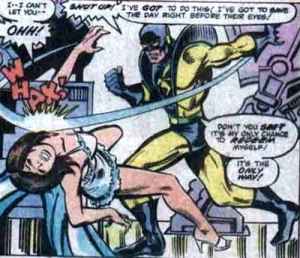
12: The Trial of Yellowjacket
Avengers # 212-230, 1981-1983
Jim Shooter, David Michelinie, Steven Grant, Roger Stern, Alan Kupperberg, Bob Hall, Alan Weiss, Don Perlin, Greg Larocque, Mark Bright, Sal Buscema & Al Milgrom
Hank Pym, founding member of The Avengers dominated the Marvel headlines in the early 1980’s, but not for good reasons. Hank Pym also known as Ant-Man and Giant Man was the first real hated hero in Marvel. He is a brilliant scientist but his domestic abuse of his wife led to a polarizing controversy that still plagues him today. Pym, married to Janet van Dyne, also known as Wasp struggled with his inadequacies as a scientist and superhero. He was jealous of Wasp’s success as a fashion designer and Avenger. Pym had trouble living with the guilt of creating Ultron, one of the greatest villains the Avengers faced. He decided to create a new robot that only he could defeat and sent it loose against the Avengers. Wasp discovers his plot and attempts to stop him. Pym strikes her down and fails in his attempt to stop the robot. He is later kicked off the Avengers and divorced from Wasp. After an attempted robbery where he was under the control of the super villain Egghead, Pym is arrested and must stand trial for his actions. The subsequent aftermath finds Hank Pym alone, depressed, hated and penniless.
11: The Kid Who Collects Spider-Man
Amazing Spider-Man #248, 1984
Roger Stern & Ron Frenz
A touching backup story written as a human interest piece. Spider-Man’s greatest fan, Tim Harrison has spent his young life collecting newspaper clippings of Spider-Man’s adventures and the Daily Bugle’s retractions. Spider-Man meets this young fan and gives him the story of a lifetime. He reveals that he is Peter Parker and tells the boy of his Uncle Ben’s death and how that inspired him to become the hero he is. As Spider-Man leaves Tim’s room, a newspaper caption states Tim Harrison’s last wish is to meet Spider-Man as he will die of Leukemia in a few days.
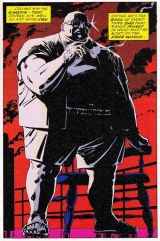
10: Born Again
Daredevil #227-233, 1986
Frank Miller & David Mazzucchelli
A great story similar to Kraven’s Last Hunt where Daredevil loses everything, his business, home, money and friends. His downfall comes at the hands of Kingpin. The story is about perseverance. Daredevil must rebuild what the Kingpin took from him. The story turns Kingpin into the sleazy, crooked business person that gets away with everything we know today.
9: House of M
House of M #1-8, 2005 – crossover event
Brian Michael Bendis & Olivier Copiel
The Scarlet Witch re-weaves the fabric of time and transforms the Marvel Universe into her own reality where she has her two sons. Prior to House of M, she believed her sons were real and Dr. Strange helped her cope with the loss of them. The desire to be reunited with her sons now that her husband, Vision is dead is what drives her to reshape the Marvel Universe. Magneto sits as ruler of all mutants and the X-Men and Avengers get their deepest desires. Wolverine and Mystique are the elite agents of S.H.I.E.L.D., Captain America has aged into an old war veteran, Dr. Strange is a psychologist, Spider-Man is married to Gwen Stacy and Luke Cage is the leader of a resistance. As this new world begins to crumble apart, Scarlet Witch utters the words; “No more mutants” and all but 198 mutants lose their powers.
8: Planet Hulk/World War Hulk
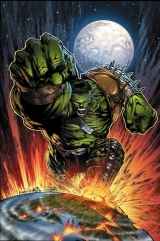
Planet Hulk – Incredible Hulk vol.2 #92-105, 2006-2007
Greg Pak & Carlo Pagulayan
World War Hulk – World War Hulk #1-5 and Incredible Hulk vol.2 # 106-111, 2007-2008 – crossover story
Greg Pak & John Romita, Jr.
After The Illuminati banishes Hulk from Earth (prior to Civil War) for fear that the Hulk is to dangerous he “smash-lands” on planet Sakaar and is forced to compete in a gladiatorial arena by their Red King. The Hulk quickly rises to the ranks of Alpha Gladiator. He eventually makes allies and helps overthrow the Red King whom he defeats in battle. He is crowned King of Sakaar. Hulk and his wife Caiera rule Sakaar together and Hulk is branded a savior. Hulk decides to stay with his wife and unborn son instead of returning to Earth. As a monument is erected in his honor using the remains of his ship, a self destruct sequence begins and decimates the now peaceful city he rules, killing his wife. Completely enraged Hulk returns to Earth with his Warbound allies and begins World War Hulk. WWH is the most aggressive, action packed Hulk story ever told. He vows revenge on The Illuminati and any that stand with them. He defeats just about every Marvel hero and eventually himself.
7: Under Siege – Avengers
Avengers 270-277, 1986-1987
Roger Stern & John Buscema
Is there anything better than a story where our heroes lose everything only to rise up with a last-ditch effort to save the day? No. Baron Zemo leads a new Masters of Evil with Mr. Hyde, the Wrecking Crew, Blackout and others to destroy the Avengers, beginning with their mansion and Jarvis. Hercules gets turned against his own team and is eventually defeated by a bearded Thor, Black Knight and the rest of the Avengers. From the destruction, the Avengers create a new team lineup to rebuild. This story also served as a model for Avengers: Disassembled.
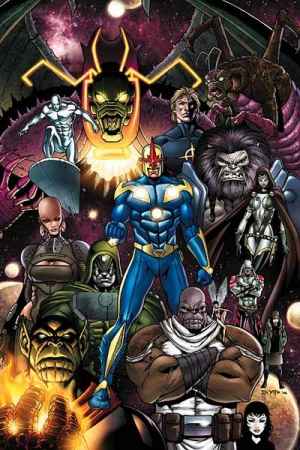
6: Annihilation
Annihilation #1-6, 2006 – enormous crossover event
Keith Giffen & Andrea Di Vito
Annihilation was a massive crossover event that reshaped Marvel’s Cosmic Universe. The premise is Annihilus sends the annihilation wave (an armada of warships and aliens life forms) from the negative zone into our universe with the intent to destroy all in his way and seize control. The key players in the story opposing Annihilus are Silver Surfer, Nova, Ronan the Accuser and Super Skrull. They each had a mini-series that ran concurrently with Annihilation. 14 creators told the main storyline and included dozens of heroes and villains. The aftermath of this story is still effecting the Cosmic Universe and helped revitalize an entire stable of characters from Marvel’s archives.
5: Kree/Skrull War
Avengers # 89-97, 1963
Roy Thomas & Sal Buscema, Neal Adams & John Buscema
The two major alien races in Marvel Universe fight as the Avengers try to end this galaxy threatening war. This storyline would shape the Marvel Cosmic Universe for years to come. The Avengers stand between two warring alien races as outsiders providing a voice of reason that is not openly accepted. The greatest moment in the story is when Ant-Man travels inside Vision to repair him after the Avengers are attacked by cows that were really the shape-shifting Skrulls.
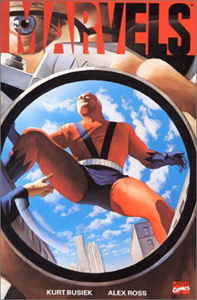
4: Marvels
Marvels #1-4, 1994
Kurt Busiek & Alex Ross
Phil Sheldon, newspaper photographer narrates the beginnings of the Marvel Universe from the common man’s perspective. Engaging, honest storytelling and incredible painted art from Alex Ross make this unique look back at Marvel’s original superheroes a must read. Busiek and Ross would also create Astro City based on the same concept.
3: Days of Future Past
Uncanny X-Men # 141-142, 1981
Chris Claremont & John Byrne
Surprisingly, this 2 issue story left a major impact on Marvel’s mutants and continues to influence the characters today. The story alternates between present day, 1980 and the distant future of 2013 where sentinels have hunted down and killed or imprisoned most mutants. This is the time period that Cable, Bishop and Rachel Grey-Summers are from. Kitty Pryde’s mind is sent back in time to convince the present day X-Men that they must prevent the murder of Senator Kelly to avoid this bleak future.
2: Spider-Man: Blue
Spider-Man: Blue #1-6, 2002-2003
Jeph Loeb & Tim Sale
The greatest love story in Marvel Comics gets expanded on by Jeph Loeb and Tim Sale. The entire series is Peter Parker describing how he met and fell in love with Gwen Stacy into a tape recorder. The flashbacks illustrated by Tim Sale have a soft, pastel tone that lends itself to the love story. A great blend of action and dialogue with sincerity that leaves an impression on the readers.
1: Captain America joins the Avengers
Avengers #4, 1964
Stan Lee & Jack Kirby
The greatest generation’s home-grown hero joins The Mighty Avengers. Not only is this possibly the most significant meeting of superheroes in Marvel Comics history but it bridges the gap between Timely, Atlas and Marvel to unify the 3 eras of Marvel’s foundation. We have Timely’s Sub Mariner finding Captain America’s frozen body and throwing him into the ocean to thaw. Atlas’ war comic genre veteran Captain America is saved by Marvel Comics core superheroes The Avengers. The result is a masterfully crafted, timeless tale created by Jack “King” Kirby and Stan “The Man” Lee.
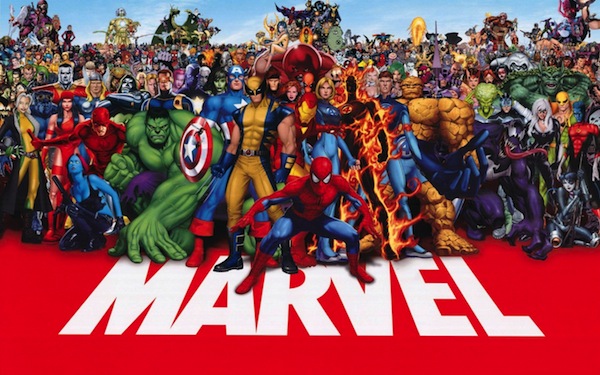
Make Mine Marvel
Marvel is continuing to pave the way as the industry standard in superhero comics. Marvel Comics has experienced the traditional highs and lows of any industry. It was renamed, sold and purchased multiple times, most recently by Disney and has persevered through tough economic times. The medium of comic books have evolved from illustrated pulp stories to high action crossover superhero tales. Generations of readers have grown up reading comic books and all have their own list of moments that make Marvel unique to them. That is the beauty of the company. It has stories, characters and creators for everyone. Now, more than ever, the diversity of the Marvel Universe is beginning to represent its readers. There are new creators given more control than ever before and they have loosened the reins of some of Marvel’s flagship superheroes to allow more engaging and dynamic stories. Marvel Comics is primed for a new Renaissance reminiscent of the Stan Lee and Jack Kirby days. We have many new Mighty Marvel Moments to look forward to. Happy Birthday Marvel. Excelsior!
What do you think? Leave a comment.

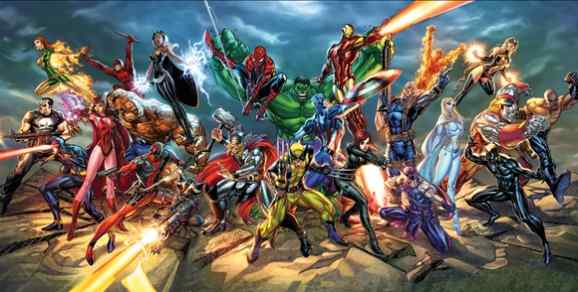
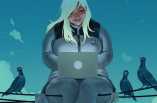
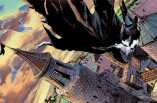
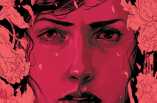
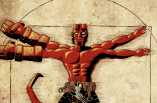
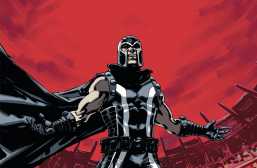
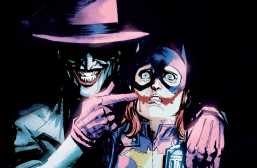
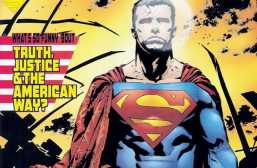
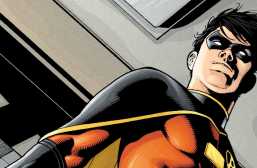
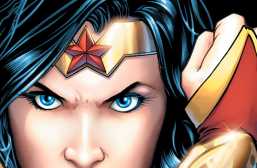
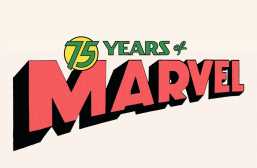
My top 2 are The invisible Girl declaring she’s the Invisible Woman in John Byrne’s FF run, and that scene in Avengers Academy where Hank Pym grew the Absorbing Man into the realm of the gods.
John Byrne’s FF run was great.
I do love Hank Pym. He is such a polarizing hero to discuss but he certainly has had some great moments.
A lot of mine are X-Men, such as:
– Phoenix dying on the moon
– Wolverine having his adamantium ripped out.
– Marvel: Onslaught when the heroes come to help the X-Men
– Legion killing his dad Charlie X by mistake.
And though all but one of those above are 1990’s moments, there were plenty during the legendary and most honourable Claremont run.
I agree with Phoenix which is why The Dark Phoenix Saga is up there.
I tried to stay away from moments that were ret-conned away. It was tough because I love so many of those 90’s stories.
I have a gazillion favorite moments and can think of as many iconic moments.
Tony Stark drunk in the IRon Man armor for the first time in Demon in a Bottle is my choice.
Great single issue and cover. I wish Marvel would have played that out further. The problem was Iron Man’s popularity didn’t allow them to completely destroy him like they did with Hank Pym.
My top three:
1. Peter’s Great Power/Great Responsibility epiphany from the origin.
2. Discovery of Cap on ice by the Avengers.
3. Spiderman destroying the soul gem to release Adam Warlock to face Thanos in Marvel Two-In One annual 2.
Good call with Spidey and Adam Warlock.
For me, maybe the most memorable and the most pivotal is Avengers discovering Captain America and pulling him out of the ice. I can not imagine Marvel becoming the power house without that character.
And it all happened in Avengers #4. I think this issue is the 2nd most important single issue in Marvel’s history. Second only to Marvel’s #1. It was their first superhero comic and had the origin’s of Namor, Angel and Human Torch. It was the first Timely comic.
The Death of Elektra by Miller was my most memorable moment.
Good one. It was hard to leave that one off but I thought Born Again was better.
Two events that stood out for me was when Dr. Strange discovers Eternity for the first time in Lee/Ditko’s Strange Tales story line and Thor’s entrance and Ultron We would have words with thee moment from Busiek/Perez’s Ultron Unlimited!
All those classic Strange Tales were good. Nice choices.
Woow amazing list. Death of Cap Marvel is the first thing that springs to mind when I saw this article.
Another tough one to leave off the list.
I feel like that had more impact when I was a kid and may not hold relevance today.
I could be wrong.
That is a very fine and well done moment in comics. Particularly when Thanos arrives for that last battle with Marvel.
Number one most memorable Marvel Comics moment is in The Amazing Spider-Man #33, Ditko’s Spider-Man throwing off the machinery to save Aunt May.
Anything else can only, at very best, come in second to that special moment.
Excellent example of a personally favorite moment. One of my all time favorite moment is during Civil War when Punisher meets Captain America after rescuing Spider-Man. Cap then precedes to beat Punisher bloody for killing Jack-O-Lantern and the Punisher being the good military man he is takes it like he should from his superior officer and hero.
Human Torch finding out Spider-Man’s secret identity (and who he’s married to!) in Spider-Man/ Human Torch #4
Great humor in that. It’s like a buddy cop movie.
I love Marvel! Mostly classic moments!
Most of the list is hard to argue with! Nice.
What about Spidey lifting the Master Planner’s device? It is clearly one moment, but goes on for like 6 pages (which is the beauty of it, really).
Any idea what issue that is from? I vaguely remember it but cannot place it.
Most of the historical moments (big deaths, etc.) were already spoiled by the time I read them.
00s and 10s, have given us a lot of memorable moments that I will never – EVER – forget.
The wedding of Peter and Mary Ja…oh, wait. That never happened. Sorry.
HA! That’s Marvel continuity for you.
Fantastic Four *51:
The scientist masquerading as Ben Grimm saves Reed Richards life.
Fantastic Four *511:
Fantastic Four meets Jack Kirby
Spider-Man finds Uncle Ben’s killer in Amazing Fantasy is a mental moment.
The Vision cries after being offered membership in the Avengers is the funniest moment for me hahaha
I love when Vision vomits out little Ultron bombs in Avengers Disassembled and then She Hulk tearing him in half.
Kitty Pryde confronting Reverend Stryker should be here.
God Loves Man Kills is one I kept off but I think it carries a little more weight now because of the movies.
Many of my moments won’t be on anyone else’s top 10 (“that time Howard the Duck realized how pointless it would be to fight a Canadian super villain”).
What about Zombie Howard The Duck?
The top three of mine involve people dying…what does that say about myself? (What does that say about the comic book industry?)
I’m really happy to see this posted! Great work 😀
Thanks for your help Jemarc.
It is fun thinking back on some of the most memorable moments of my childhood – back to the days when there was no computer games, no Internet, nothing much to do except read and re-read and re-re-read my beloved comics over and over again.
There were some obscure but memorable moments from the 80s-90s runs of She Hulk, Alpha Flight… and well, a lot of recent “moments”.
Stan Lee posing for the cover of Black Rider 8! Who can forget.
Spider-Man… Good (origin, death of Gwen) and bad (selling his marriage to the devil) alike, Spider-Man stories tend to excel in giving iconic moments that stick, while other characters’ story arcs so frequently just fade into background noise.
This is amazingly put together. I love that you had categories. Obviously spent a lot of time on this, great job.
Thank.
Glad you enjoyed it.
It is all about the 1970’s.
V. glad to see the Green Goblin Reborn storyline on the list. The Comics Code was a blight on the creativity of an entire medium, and that was the story that broke the CCA’s hold.
As a childhood DC fan, however, I must quibble with your very first entry. Stan Lee is extraordinary, but he is ONE OF the fathers of the superhero genre, not the only daddy. 🙂
I will concede to your Stan Lee point with one statement. Stan Lee created more superhero comics than anyone else. With all due respect to Siegel,Schuster, Kane and Finger, Stan built a genre, they created the templates.
The salute at the end of G.I. Joe: A Real American Hero #34. It is one of the most memorable moments in comics ever for me!
And G.I. Joe #21 is a comic I would list in the top ten of comics I have ever “read”.
I loved that series.
Fantastic article. Thanks for all the great suggestions. I have always been a huge X-Men and Spiderman, but I am just now getting into the other Marvel worlds. Chris Claremont has become one of my favorites over the past few years.
This is a great article about the Marvel Universe. I’m glad to see House of M has made it on here! I also loved the relatively unknown Childhood’s End storyline.
Oooohhh! I never read all of that. I just looked it up and am going to pick it up at my comic shops this week. I love Craig Kyle. Thanks Kristin.
This thing is a beast Jamie! Great work, and although I have never even held a comic book (crazy, right?), you make me feel a sense of nostalgia towards these characters, writers, and all people of comic influence.
Thanks Danny.
I am shocked and maybe a little offended you have never read a comic. This needs to change. You should read Spider-Man: Blue. It is a well written love story that happens to have Spider-Man in it. I expect a full report.
And thanks for all your editing you do to my articles. It is a great help.
I am ashamed to say that I own that run of Spider-Man and have not read it.
Woah. I have some reading to do. Thank you for this wonderful article.
This list definitely needed to happen. Thank you for insight into a world I regrettably haven’t been able to traverse yet. But now, you’ve provided me a road map. Thanks.
Memorable moments are a mixture of shocks, surprises and pure drama.
What an in depth examination of the giant that is Marvel! Well done!
Thank you Jamie for all your hard work and putting this material down in one place as point of reference for novice like myself.
Jamie,
This is an impressive list, and a valuable resource. I like the way that you have essentially framed a cultural history of comics alongside an apt analysis of the medium and its creators.
Now Thor’s hammer has been picked up by Mjolnir– a powerful, strong, noble god, and a woman! When we look back at this move in a decade or so, I think it will be clearly indicative of a cultural moment in which female heroines had to become stronger and more central to stories (films, tv shows, YA novels, comics) to accommodate an audience that desired such equal representations. It will certainly go down in comics history as a Mighty Marvel Moment.
I agree 100%.
the article I’m working on now will explore this theme to an extent.
Marvel was more of animation for me, but you brought the other side of this giant. The original and epic side. I’ve only read a few Spider-man comics and Avengers ones too. If I find more easily, I’ll give Marvel a big try.
This is a great reference point for those of us entering the world of comic books. I have been looking for an accurate and worthwhile place to visit to read all about the Marvel universe. Thank you for the convenient, well-written and intriguing piece.
A really great guide for someone just getting into Marvel, very in-depth and informative. Great job.
Civil war was my favorite and cemented my interest in comics
I think the biggest moment you missed is when Spiderman failed to save Gwen Stacey from the Green Goblin in “The Night Gwen Stacey Died”. It was the first time a superhero failed, and not simply by being too late or some other unavoidable circumstance, but actually killed the person he was trying to save in the process of saving them (her neck snaps when his web catches her as she is falling). It brought realistic consequences to a hero’s actions, pitting them in the “real world”, and showed they could not win every time. I think that moment should be on your list of moments that shaped a universe, if not be at the top of the list. I believe Stan Lee himself has said that was the biggest moment in Spider-man’s history, and arguably in all of comcs.
A great walk down memory lane for a comic fan like me. Thank you for this.